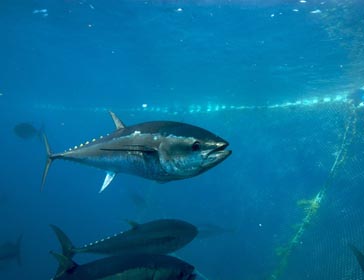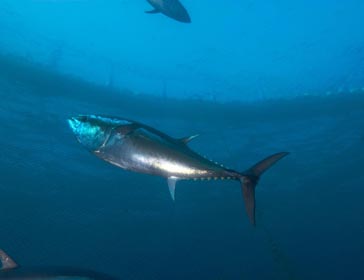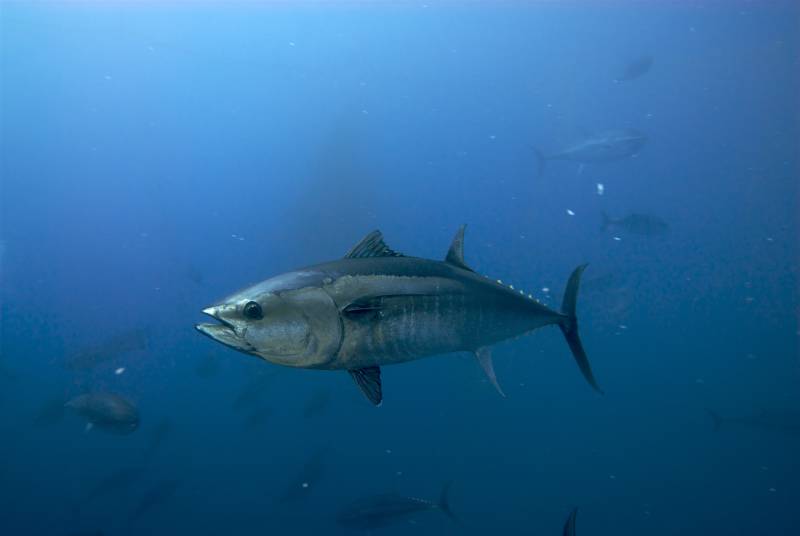Feature: Bluefin Tuna
 In the last 10 years, bluefin tuna fishing grounds have become highly profitable due to the big demand by the sushi and sashimi market. According to the last evaluation of the bluefin tuna stock in the East Atlantic and the Mediterranean, the increase in fishing pressure has caused a sharp decline in the population and a drastic reduction of reproducers’ biomass. This occurrence has caused great concern for the survival of this species. In the last few years, the sharp rise in the fleet has been encouraged by the expansion of bluefin tuna fattening cages in the Mediterranean and the increase in the fleets’ capacity. This mainly applies to the case of the industrial purse-seine, responsible for 60 to 80% of the bluefin tuna catch in this area.
In the last 10 years, bluefin tuna fishing grounds have become highly profitable due to the big demand by the sushi and sashimi market. According to the last evaluation of the bluefin tuna stock in the East Atlantic and the Mediterranean, the increase in fishing pressure has caused a sharp decline in the population and a drastic reduction of reproducers’ biomass. This occurrence has caused great concern for the survival of this species. In the last few years, the sharp rise in the fleet has been encouraged by the expansion of bluefin tuna fattening cages in the Mediterranean and the increase in the fleets’ capacity. This mainly applies to the case of the industrial purse-seine, responsible for 60 to 80% of the bluefin tuna catch in this area.
Where do bluefin tuna live?
Bluefin tuna live mainly in the North Atlantic pelagic ecosystem and its adjacent seas, especially in the Mediterranean Sea. Geographically, their population is distributed throughout the North Atlantic, from Ecuador to Norway and from the Black Sea to Mexico. Unlike other species of tuna, this is the only one that lives permanently in the temperate waters of the Atlantic.
There are two independent populations or stocks of bluefin tuna: a lesser population in the western part of the Atlantic that spawns in the Gulf of Mexico, and a greater stock in the eastern part of the Atlantic, distributed in the East Atlantic, the Mediterranean and, in the past, the Black Sea, with the Mediterranean Sea as the spawning area.
In addition, it seems that bluefin tuna exhibit a behavior of returning to their birthplace and loyalty to the breeding grounds both in the Mediterranean and in the Gulf of Mexico. This implies that the adult and young specimens from both populations feed together, particularly off the coast of North America and in the mid-Atlantic.
Why do bluefin tuna migrate?
Electronic marking studies have shown that the bluefin tuna is a highly migratory species that engages in two types of migration during its life: a trophic migration to seek food and another migration to spawn.
When the mating season begins, adults always return to the waters where they were born. Therefore, the adults born in the Gulf Mexico migrate to this area in the spring in order to spawn in April-May. Conversely, the adults born in the Mediterranean Sea return there when they reach maturity, at the end of spring, to spawn in June-July in the Western and Central areas.
How can they travel such long distances?
Bluefin tuna have a particularly well-developed circulatory system. This makes them warm-blooded fish and swift swimmers (72.5 km per hour), with a huge migration capacity.
As other species of tuna and sharks, the Atlantic bluefin tuna is a pelagic predator that needs to swim continuously in order to ventilate itself and generate enough heat to maintain its vital organs and raise its body temperature above the water’s. Its circulatory system’s complex structure enables it to minimize heat loss and maintain its internal body temperature above the sea water’s. Due to its endothermic capacity, it can withstand cold temperatures (3°C) and warm temperatures (up to 30°C).
What age can they reach?
The bluefin tuna is a long-lived and slow growing species. According to the data obtained, the lifespan of the bluefin tuna’s eastern population has been estimated at approximately 20 years, whereas the lifespan of the Western population’s specimens has been estimated at 32 years according to the radiocarbon tracking.
And what size can a bluefin tuna reach?
Adult bluefin tuna species can exceed 3 m in length. This makes them the biggest species of tuna and one of the largest teleostei, and they weigh 250 kg on average, although some can reach up to 900 kg.
How do they reproduce?
Several studies have shown that bluefin tuna each maturity at the age of 4-5 years in the East Atlantic and in the Mediterranean, whereas the West Atlantic population specimens reach sexual maturity at approximately 8 years. The difference in the age at which the eastern and western populations reach maturity in the North Atlantic may support the hypothesis of differentiated populations.
Like most fish, egg production seems to depend on age (or size). Therefore, a 5 year-old female can produce an average of five million eggs (measuring ~1 mm) per year, whereas females aged 15-20 years can carry up to 45 million eggs. Hatching occurs without parental care after an incubation period of 2 days.
Bluefin tuna larvae (3-4 mm) are generally pelagic and can be found in superficial waters throughout the Mediterranean Sea with greater concentrations in areas where there are whirlpools and fronts, especially at the end of summer. Larvae grow 1 mm per day until they reach a weight of 40-80 kg, and they separate into schools according to size.
These bluefin tuna larvae are mainly found in superficial waters with a temperature from 24 to 25ºC in areas where the water masses of the Atlantic and the Mediterranean mix.
What time of year do they reproduce?
In the Mediterranean, bluefin tuna spawn during the months of May and August with spawning peaks, depending on climate and oceanographic conditions, during June and July.
What do they eat?
Young and adult bluefin tuna specimens are large predators and opportunistic animals toward their food. Their diet can include several species of teleostei, invertebrates such as jellyfish and salps as well as dimersals and sessile organisms such as octopi, crabs and sponges, although big differences have been observed in the areas studied.
In general, young specimens feed on crustaceans, fish and cephalopods, whereas adults feed on fish such as herring (Clupea arengus), anchovies (Engraulis encrasicolus), sandeels (Ammodytes spp.), sardines (Sardina pilchardus), sprats (Sprattus sprattus), bluefish (Pomatomus saltatrix) and horse mackerel (Scomber scombrus). Three predominant species were found among the bluefin tuna stomach contents analyzed: the Atlantic herring and the sprat in the West Atlantic or the anchovy in the East Atlantic and the Mediterranean.
 Why are they endangered?
Why are they endangered?
This species’ superpredator status, and therefore slow growth makes it vulnerable to overexploitation. The Atlantic stock has currently been pushed into a risk situation. This is especially due to the fishing pressure that the industrial purse-seine has exercised upon this species, also connected to fattening cages. Fishing of individuals beneath their biological reproductive size and on breeding grounds is frequent on most Mediterranean fishing grounds. It has a clear negative impact: the stock of reproducing specimens has dwindled and has brought about a decline in the size of the big tuna. This has compromised the future of the great bluefin tuna of the Atlantic.
But in addition to this, the scarce existing marine reserves leave the door open for the direct destruction of essential habitats for reproduction and uncontrolled exploitation, all too frequently illegal, of the species. Currently, this stock’s situation is alarming because it has been estimated that the biomass is situated beneath 15% of what it was before being exploited. Consequently, in addition to strict fishing control, marine reserves and bluefin tuna breeding grounds need to be declared and the species itself needs to be protected. This is in order to drastically limit the abuse being inflicted upon bluefin tuna by the fishing industry.



 Why are they endangered?
Why are they endangered?